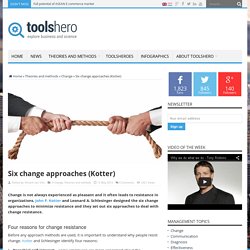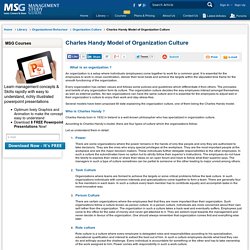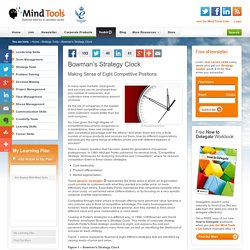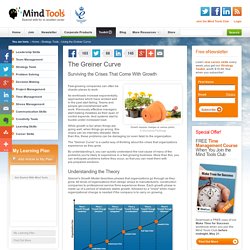

Organisational Culture (Overview) Theoretical Models - Overviews. 3.10.4 - Blockbuster & Strategic Drift. 3.10.1 Lewin's 3-Stage Model of Change. 3.10.1 Kotter's 8 Step Change Model. 3.10 Six change approaches (Kotter) Change is not always experienced as pleasant and it often leads to resistance in organizations.

John P. Kotter and Leonard A. Schlesinger designed the six change approaches to minimize resistance and they set out six approaches to deal with change resistance. Four reasons for change resistance Before any approach methods are used, it is important to understand why people resist change. Parochial self-interest – some employees are more concerned about the consequences of change for themselves.
The six change approaches Based on scientific research, Kotter and Schlesinger describe six change approaches to deal with change resistance: Education and Communication – Informing employees beforehand so that they will be involved in the change process will prevent that the information that is provided by the organization comes across as inaccurate. More information. 3.10 - Kurt Lewin's Force-Field Analysis Change Model.
Johnson 02 Strategic Drift.wmv. 3.9 Hofstede's Cultural Dimensions. Understanding Workplace Values Around the World Learn how to be more sensitive to the needs of people in different cultures.

We know that we are living in a global age. Technology has brought everyone much closer together. This means that people of different cultures find themselves working together and communicating more and more. This is exciting, but it can also be frustrating and fraught with uncertainty. Building connections with people from around the world is just one dimension of cultural diversity. How can we understand cultural differences? Fortunately, psychologist Dr Geert Hofstede asked himself this question in the 1970s. With access to people working for the same organization in over 40 countries of the world, he collected cultural data and analyzed his findings. He scored each country using a scale of roughly 0 to 100 for each dimension. The Five Dimensions of Culture The five dimensions are: 3.9 Charles Handy Model of Organization Culture. What is an organization ?

An organization is a setup where individuals (employees) come together to work for a common goal. It is essential for the employees to work in close coordination, deliver their level bests and achieve the targets within the stipulated time frame for the smooth functioning of the organization. Every organization has certain values and follows some policies and guidelines which differentiate it from others. The principles and beliefs of any organization form its culture.
The organization culture decides the way employees interact amongst themselves as well as external parties. Several models have been proposed till date explaining the organization culture, one of them being the Charles Handy model. 3.8 Bowman's Strategy Clock. Making Sense of Eight Competitive Positions © iStockphoto/Zeffss1 In many open markets, most goods and services can be purchased from any number of companies, and customers have a tremendous amount of choice.

It's the job of companies in the market to find their competitive edge and meet customers' needs better than the next company. So, how, given the high degree of competitiveness among companies in a marketplace, does one company gain competitive advantage over the others? And when there are only a finite number of unique products and services out there, how do different organizations sell basically the same things at different prices and with different degrees of success?
This is a classic question that has been asked for generations of business professionals. Cost leadership.Product differentiation.Market segmentation. Competing through lower prices or through offering more perceived value became a very popular way to think of competitive advantage. Figure 1 – Bowman's Strategy Clock. 3.8 Greiner Curve - Strategy Tools. Surviving the Crises That Come With Growth Growth requires changes at various points. © iStockphoto/PaulGregg Fast-growing companies can often be chaotic places to work.

As workloads increase exponentially, approaches which have worked well in the past start failing. 3.8 The Strategy clock. 3.7 Kaplan & Norton's Balanced scorecard. 3.7 Kaplin & Norton - Balanced Scorecard Model. 3.6 Leadership Styles: Tannenbaum & Schmidt Continuum. 3.7 Triple bottom line & sustainability: the science of good business. 3.2 Blake Mouton Managerial Grid. Balancing Task- and People-Oriented Leadership © iStockphotoanthonyjhall When your boss puts you in charge of organizing the company Christmas party, what do you do first?

Do you develop a time line and start assigning tasks, or do you think about who would prefer to do what, and try to schedule around their needs? When the planning starts to fall behind schedule, what is your first reaction? Do you chase everyone to get back on track, or do you ease off a bit, recognizing that everyone is busy just doing his/her job, let alone the extra tasks you’ve assigned? Your answers to these types of questions can reveal a great deal about your personal leadership style. Neither preference is right or wrong, just as no one type of leadership style is best for all situations. A popular framework for thinking about a leader’s ‘task versus person’ orientation was developed by Robert Blake and Jane Mouton in the early 1960s.
Understanding the Model Figure 1 – The Blake Mouton Managerial Grid Note: